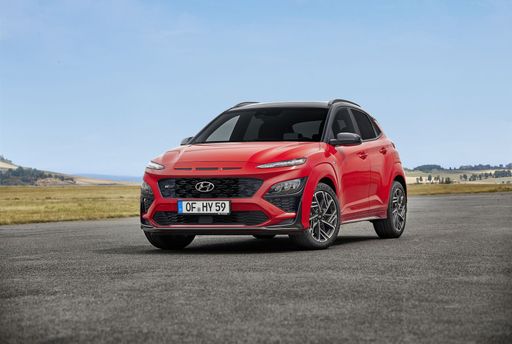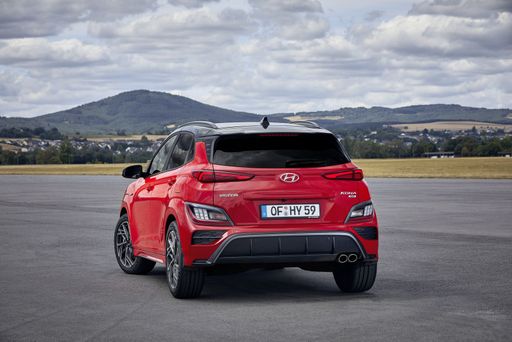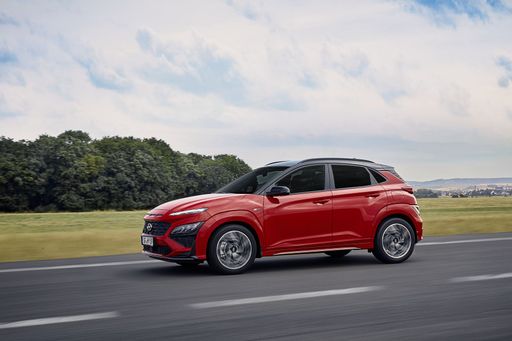Hyundai Kona vs BYD Seal 6 – Which one offers the better deal?
Two cars, one duel: Hyundai Kona meets BYD Seal 6.
Which one wins in performance, efficiency and value for money? Find out now!
Here’s where it gets real: The technical differences in detail
Costs and Efficiency: Looking at overall running costs, both models reveal some interesting differences in everyday economy.
Hyundai Kona has a decisively advantage in terms of price – it starts at 23100 £, while the BYD Seal 6 costs 36800 £. That’s a price difference of around 13791 £.
Fuel consumption also shows a difference: the BYD Seal 6 manages with 1.70 L and is therefore decisively more efficient than the Hyundai Kona with 4.60 L. The difference is about 2.90 L per 100 km.
As for range, the Hyundai Kona performs decisively better – achieving up to 514 km, about 414 km more than the BYD Seal 6.
Engine and Performance: Power, torque and acceleration say a lot about how a car feels on the road. This is where you see which model delivers more driving dynamics.
When it comes to engine power, the Hyundai Kona has a minimal edge – offering 218 HP compared to 212 HP. That’s roughly 6 HP more horsepower.
In acceleration from 0 to 100 km/h, the Hyundai Kona is minimal quicker – completing the sprint in 7.80 s, while the BYD Seal 6 takes 8.50 s. That’s about 0.70 s faster.
In terms of top speed, the Hyundai Kona performs somewhat better – reaching 210 km/h, while the BYD Seal 6 tops out at 180 km/h. The difference is around 30 km/h.
Space and Everyday Use: Beyond pure performance, interior space and usability matter most in daily life. This is where you see which car is more practical and versatile.
Both vehicles offer seating for 5 people.
In curb weight, the Hyundai Kona is clearly lighter – 1370 kg compared to 1710 kg. The difference is around 340 kg.
In terms of boot space, the BYD Seal 6 offers slight more room – 500 L compared to 466 L. That’s a difference of about 34 L.
In maximum load capacity, the BYD Seal 6 performs a touch better – up to 1535 L, which is about 235 L more than the Hyundai Kona.
When it comes to payload, Hyundai Kona a touch takes the win – 490 kg compared to 435 kg. That’s a difference of about 55 kg.
All in all, the BYD Seal 6 shows itself to be edges out a narrow win and secures the title of DriveDuel Champion.
It impresses with the more balanced overall package and proves to be the more versatile companion for everyday use.
Hyundai Kona
The Hyundai Kona blends a bold design with a versatile interior, making it a standout choice in the compact SUV market. Its crisp handling and responsive steering provide an engaging driving experience, whether in the city or on the open road. The vehicle also offers a range of features designed to enhance comfort and connectivity, ensuring a pleasurable journey for both driver and passengers.
details @ hyundai.news
@ hyundai.news
 @ hyundai.news
@ hyundai.news
 @ hyundai.news
@ hyundai.news
 @ hyundai.news
@ hyundai.news
BYD Seal 6
The BYD Seal 6 is a captivating electric sedan that captures attention with its sleek design and modern aerodynamics. With a strong focus on sustainability, it offers an impressive electric driving experience, combining efficiency with cutting-edge technology. The Seal 6 stands out in the EV market for its luxurious interior and innovative features, making it a strong contender for drivers looking to embrace the future of transportation.
details

|
|
|
|
|
Costs and Consumption |
|
|---|---|
|
Price
23100 - 41600 £
|
Price
36800 - 42800 £
|
|
Consumption L/100km
4.6 - 7 L
|
Consumption L/100km
1.7 - 2.6 L
|
|
Consumption kWh/100km
14.6 - 16.8 kWh
|
Consumption kWh/100km
-
|
|
Electric Range
377 - 514 km
|
Electric Range
50 - 100 km
|
|
Battery Capacity
1.3 - 65.4 kWh
|
Battery Capacity
-
|
|
co2
0 - 163 g/km
|
co2
38 - 60 g/km
|
|
Fuel tank capacity
38 - 47 L
|
Fuel tank capacity
65 L
|
Dimensions and Body |
|
|---|---|
|
Body Type
SUV
|
Body Type
Estate
|
|
Seats
5
|
Seats
5
|
|
Doors
5
|
Doors
5
|
|
Curb weight
1370 - 1773 kg
|
Curb weight
1710 - 1805 kg
|
|
Trunk capacity
466 L
|
Trunk capacity
500 L
|
|
Length
4350 - 4385 mm
|
Length
4840 mm
|
|
Width
1825 mm
|
Width
1875 mm
|
|
Height
1580 - 1585 mm
|
Height
1505 mm
|
|
Max trunk capacity
1300 L
|
Max trunk capacity
1535 L
|
|
Payload
420 - 490 kg
|
Payload
435 kg
|
Engine and Performance |
|
|---|---|
|
Engine Type
Electric, Petrol, Full Hybrid
|
Engine Type
Plugin Hybrid
|
|
Transmission
Automatic, Manuel
|
Transmission
Automatic
|
|
Transmission Detail
Manual Gearbox, Dual-Clutch Automatic
|
Transmission Detail
CVT
|
|
Drive Type
Front-Wheel Drive, All-Wheel Drive
|
Drive Type
Front-Wheel Drive
|
|
Power HP
115 - 218 HP
|
Power HP
184 - 212 HP
|
|
Acceleration 0-100km/h
7.8 - 11.9 s
|
Acceleration 0-100km/h
8.5 - 8.9 s
|
|
Max Speed
162 - 210 km/h
|
Max Speed
180 km/h
|
|
Torque
200 - 265 Nm
|
Torque
-
|
|
Number of Cylinders
3 - 4
|
Number of Cylinders
4
|
|
Power kW
85 - 160 kW
|
Power kW
135 - 156 kW
|
|
Engine capacity
998 - 1598 cm3
|
Engine capacity
1498 cm3
|
General |
|
|---|---|
|
Model Year
2024 - 2025
|
Model Year
2025
|
|
CO2 Efficiency Class
A, D, C, E, F
|
CO2 Efficiency Class
B
|
|
Brand
Hyundai
|
Brand
BYD
|
Is the Hyundai Kona offered with different drivetrains?
Available configurations include Front-Wheel Drive or All-Wheel Drive.
The prices and data displayed are estimates based on German list prices and may vary by country. This information is not legally binding.
